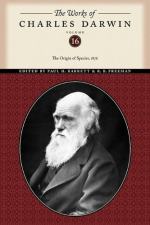
|
| Name: _________________________ | Period: ___________________ |
This test consists of 15 multiple choice questions and 5 short answer questions.
Multiple Choice Questions
1. How many objections does Darwin say there are about natural selection?
(a) 4.
(b) 3.
(c) 1.
(d) 2.
2. What does the process of species growth suggest about species that are transported into foreign regions?
(a) They do not prosper.
(b) They stay stagnant.
(c) They inter-breed.
(d) They prosper.
3. What type of selection primarily affects the reproductive characteristics of a species?
(a) Artificial selection.
(b) Sexual selection.
(c) Natural selection.
(d) Environmental selection.
4. What does natural selection say about the most distinct characteristic of a species?
(a) It will be the largest change.
(b) It will be the smallest change.
(c) It is the most recently changed.
(d) The change is seen in ancestors.
5. What can some amount of variation be attributed to?
(a) Size of species.
(b) External conditions.
(c) Location of species.
(d) Genetics.
6. What typically happens when varieties are inter-breed?
(a) Offspring are weaker.
(b) Offspring are stronger.
(c) Variations die out.
(d) Variations increase.
7. What would a variety do in order to become a new species?
(a) Reduce in numbers.
(b) Inter-breed.
(c) Migrate.
(d) Exceed in numbers from the parent species.
8. Which of the following occurs when one type of variation causes variation in another part of an organism?
(a) Correlation of growth.
(b) Mulitvariation.
(c) Misallocation of variation.
(d) Normal variation.
9. What bodily system do some scientists believe is responsible for producing individual differences?
(a) Skin.
(b) Nervous.
(c) Reproductive.
(d) Brain.
10. Which of the following is a radical change in the structure or behavior of an organism?
(a) Monstrosities.
(b) Increased illness.
(c) Growth.
(d) Extinction.
11. Who believed that humans would fall into starvation because they could not meet the needs of the population?
(a) Hooker.
(b) Darwin.
(c) Maltus.
(d) Newton.
12. With respect to breeders, what leads to the development of different varieties of species when breeding?
(a) Natural selection.
(b) Purposeful selection.
(c) Genetic selection.
(d) Accidental selection.
13. Which of the following tends to live over larger areas?
(a) Subspecies.
(b) Mammals.
(c) Species.
(d) Variations.
14. What does natural selection favor in terms of increasing population?
(a) Traits that lead to reproduction.
(b) Traits that lead to strength.
(c) Traits that lead to sterility.
(d) Traits that do not lead to reproduction.
15. What does Darwin suggest about variation for parts that are NOT specialized?
(a) Less variation.
(b) Eventually stops.
(c) More variation.
(d) Becomes correlational.
Short Answer Questions
1. What happens when species are inter-bred?
2. Which of the following refers to a scientist who studies living creatures?
3. What is the primary cause for the struggle for survival between species?
4. When is the only time a rational conclusion can be reached on a theory?
5. In Chapter 4: Natural Selection, what does Darwin suggest about most variations?
|
This section contains 458 words (approx. 2 pages at 300 words per page) |

|




